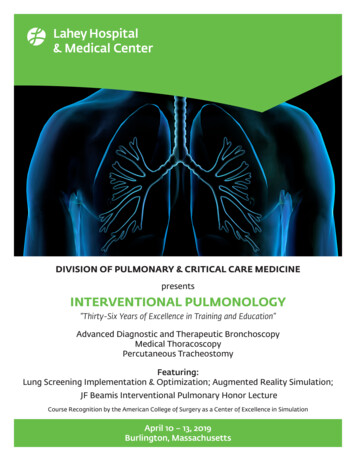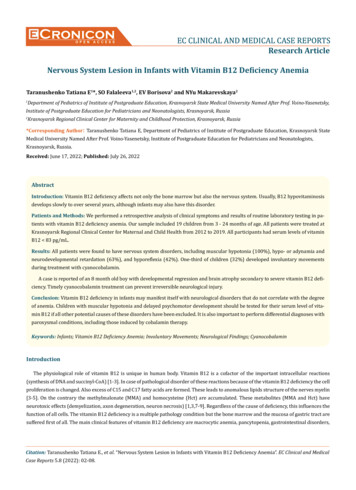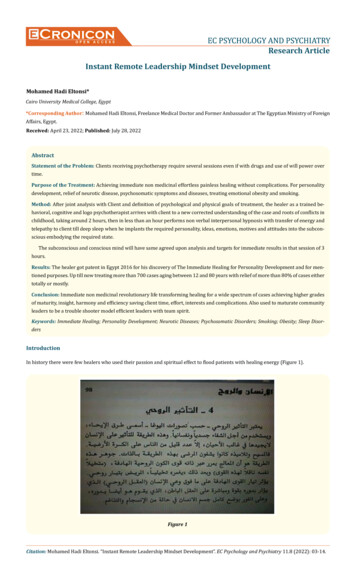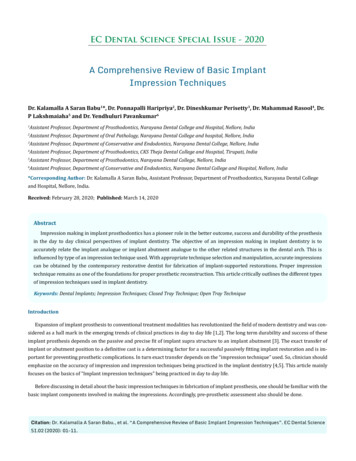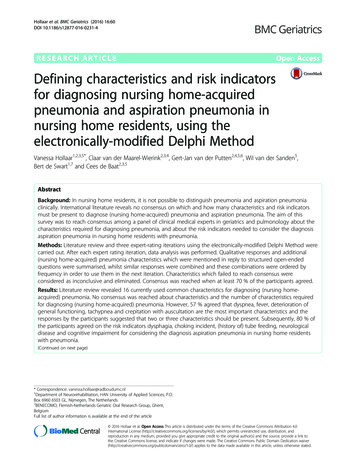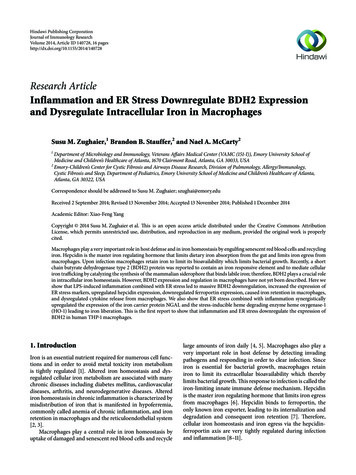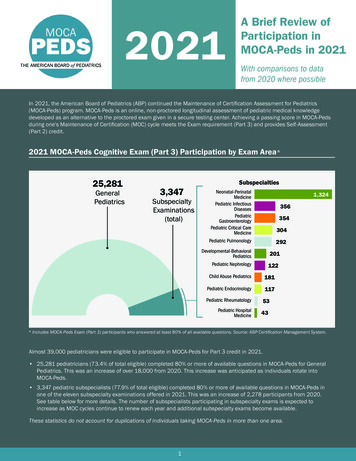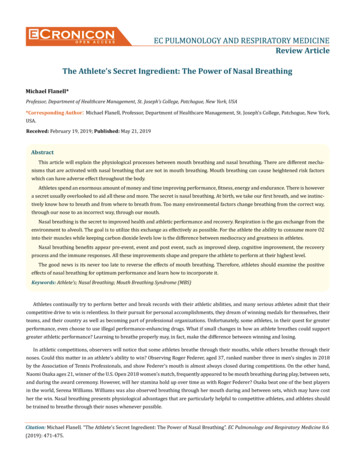
Transcription
CroniconO P ENA C C ESSEC PULMONOLOGY AND RESPIRATORY MEDICINEReview ArticleThe Athlete’s Secret Ingredient: The Power of Nasal BreathingMichael Flanell*Professor, Department of Healthcare Management, St. Joseph’s College, Patchogue, New York, USA*Corresponding Author: Michael Flanell, Professor, Department of Healthcare Management, St. Joseph’s College, Patchogue, New York,USA.Received: February 19, 2019; Published: May 21, 2019AbstractThis article will explain the physiological processes between mouth breathing and nasal breathing. There are different mecha-nisms that are activated with nasal breathing that are not in mouth breathing. Mouth breathing can cause heightened risk factorswhich can have adverse effect throughout the body.Athletes spend an enormous amount of money and time improving performance, fitness, energy and endurance. There is howevera secret usually overlooked to aid all these and more. The secret is nasal breathing. At birth, we take our first breath, and we instinc-tively know how to breath and from where to breath from. Too many environmental factors change breathing from the correct way,through our nose to an incorrect way, through our mouth.Nasal breathing is the secret to improved health and athletic performance and recovery. Respiration is the gas exchange from theenvironment to alveoli. The goal is to utilize this exchange as effectively as possible. For the athlete the ability to consume more O2into their muscles while keeping carbon dioxide levels low is the difference between mediocracy and greatness in athletes.Nasal breathing benefits appear pre-event, event and post event, such as improved sleep, cognitive improvement, the recoveryprocess and the immune responses. All these improvements shape and prepare the athlete to perform at their highest level.The good news is its never too late to reverse the effects of mouth breathing. Therefore, athletes should examine the positiveeffects of nasal breathing for optimum performance and learn how to incorporate it.Keywords: Athlete’s; Nasal Breathing; Mouth Breathing Syndrome (MBS)Athletes continually try to perform better and break records with their athletic abilities, and many serious athletes admit that theircompetitive drive to win is relentless. In their pursuit for personal accomplishments, they dream of winning medals for themselves, theirteams, and their country as well as becoming part of professional organizations. Unfortunately, some athletes, in their quest for greaterperformance, even choose to use illegal performance-enhancing drugs. What if small changes in how an athlete breathes could supportgreater athletic performance? Learning to breathe properly may, in fact, make the difference between winning and losing.In athletic competitions, observers will notice that some athletes breathe through their mouths, while others breathe through theirnoses. Could this matter in an athlete’s ability to win? Observing Roger Federer, aged 37, ranked number three in men’s singles in 2018by the Association of Tennis Professionals, and show Federer’s mouth is almost always closed during competitions. On the other hand,Naomi Osaka ages 21, winner of the U.S. Open 2018 women’s match, frequently appeared to be mouth breathing during play, between sets,and during the award ceremony. However, will her stamina hold up over time as with Roger Federer? Osaka beat one of the best playersin the world, Serena Williams. Williams was also observed breathing through her mouth during and between sets, which may have costher the win. Nasal breathing presents physiological advantages that are particularly helpful to competitive athletes, and athletes shouldbe trained to breathe through their noses whenever possible.Citation: Michael Flanell. “The Athlete’s Secret Ingredient: The Power of Nasal Breathing”. EC Pulmonology and Respiratory Medicine 8.6(2019): 471-475.
The Athlete’s Secret Ingredient: The Power of Nasal Breathing472Respiration is a fundamental physiological process and finding the most efficient breathing mode during exercise warrants furtherexploration. Breathing, or ventilation, is the process of gas exchange from the outside environment to the alveoli. For optimal athleticperformance, the goal is to utilize oxygen (O2) as efficiently as possible. The greatest athletes in the world are able to consume more O2 intheir muscles while keeping carbon dioxide (CO2) levels low [1].Mouth breathing syndrome (MBS) is characterized by inhaling and exhaling primarily through the mouth and is considered to be anabnormal respiratory function. According to Capotamoc de Souza [2], MBS is a pathology that is associated with the obstruction of theupper airways and increased resistance of nasal breathing. MBS can be induced by factors such as tonsil hyperplasia hypertrophic tur-binates, rhinitis, tumors, infections, inflammatory disease, and abnormalities in nasal architecture. Another cause of MBS is improperlydeveloped orofacial muscles from infancy due to factors such as bottle feeding, finger sucking and/or nonnutritive sucking, making thosemuscles more flaccid and hypotonic [3]. Prolonged mouth breathing can lead to muscular and postural alterations, which may causedentoskeletal changes [4]. Consequently, the habit of breathing through the mouth, even without obstruction, alters the balance of facialmuscles and causes facial skeletal changes.Many healthcare professionals are unaware of the negative effects of MBS and that MBS leads to changes in tongue and head position.With MBS, the location of tongue is down and backwards instead of up and forward in the palate. The tongue position influences the pala-tal development, which if not properly positioned, can result in a deep vaulted hard palate and a deviated septum contributing to MBS,instead of a domed formation and properly formed septum. The tongue resting in the lower jaw can cause a forward head position. Everyinch of forward head posture increases the weight of the head on the spine by approximately 10 pounds [5] creating an adverse load onthe cervical joints, induced by poor spinal, cervical, and scapular postures. Additionally, the forward head position may strain the deeppostural-stabilizing muscles of the spine, reducing the performance of their functional postural-supporting role [6].Figure: Source [5].A significant problem with MBS is the reduction of oxygen absorption leading to a downward spiraling effect on sleep, stamina, andenergy levels, all vital to the athlete. This effect is caused by inhaling too much oxygen and exhaling large amounts of carbon dioxide,needed for the transfer of oxygen from the hemoglobin molecule during respiration in the lungs. Breathing through the mouth alsocauses dryness of the oral and pharyngeal tissues and may lead to inflamed tonsils, tonsil stones, dry cough, swollen tongue, halitosis, andCitation: Michael Flanell. “The Athlete’s Secret Ingredient: The Power of Nasal Breathing”. EC Pulmonology and Respiratory Medicine 8.6(2019): 471-475.
The Athlete’s Secret Ingredient: The Power of Nasal Breathing473gingivitis. Mouth breathers also chew with their mouths open and swallow air, leading to gas, bloating, flatulence, and burping. In addition, lips become dry and flaccid because they do not stay closed to provide the necessary lip seal [7].Mouth breathing causes biochemical, physiological, and immunological disturbances. Among the biochemical and physiological dis-orders related to MBS are lower oxygen absorption (chronic hypoxemia), increased CO2 concentration (hypercapnia), and changes in theacid-base balance, towards respiratory acidosis. Mouth breathing is also associated with increased water loss, decreased energy, andchanges in salivary profile resulting in a greater risk of heat stress and disrupted muscle function, thus negatively affecting athletic per-formance due to dehydration. According to Garcia Triana [8], healthy subjects experienced a 42% decrease in net water loss when theyswitched their breathing mode from nasal to oral expiration during tidal breathing.Additionally, mouth breathing can cause changes in sleep patterns, which can contribute to a decrease in immune defense cells andan increase in humoral serum values related to inflammatory mediators, indicating the occurrence of oxidative stress and an altered systemic inflammatory state. Considering the athlete as a patient, a reduction in the quality or quantity of sleep can result in biological andcognitive imbalance, potentially decreasing physical performance and the recovery process after a workout [2]. In addition, the decreasein immune defenses cells puts the athlete at risk for contracting illnesses, which may compromise performance during the athletic event.The nose has numerous functions: olfaction, sensation, mucociliary clearance, filtration, and immunological functions. In addition,the nose has the function of regulating air from cold to warm and humidifying the air during the nasal cycles of airflow dynamics. Nasal breathing cleans the air as it enters the body, produces nitric oxide (NO), and performs the same amount of work with less energyexpended. Immunological functions of the nose produce mucus and secrete immunoglobulins. The nose has its own self-defense dueto its coarse hairs (vibrissae) and the secretions it creates. In addition, the nose protects the lungs from allergens, toxicants, and otherbacteria through its immunologic properties. Mucociliary clearance promotes mucus and cilia functions: to filter and trap toxicants andtransport airborne particles [9]. According to Lacomb [1], humidification occurs within 80% of the air before it reaches the lungs. Air isheated through conduction, convection, and radiation with blood flow in the opposite direction to incoming airflow, allowing for greaterefficiency in warming the air.As ambient oxygen (O2) passes through the sinuses, it diffuses across the nasal epithelium and can be used by the cells to produceNitric Oxide (NO). As the sinuses produces NO and air is continuously inhaled, NO reaches the lungs and is diffused into the capillaries ofthe surrounding alveoli, expanding vessels and increasing O2/CO2 exchange.Lungberg [10], noted that the release of NO helps to control blood flow via diffusion to the underlying smooth muscles cells. The pow-erful vasodilating effects of NO lead to increased oxygen uptake, a reduction in pulmonary vascular resistance, and arterial oxygenation.The benefits of enhanced NO productivity include increased aerobic capacity, reduced hypertension, increased insulin sensitivity andglucose tolerance, capillarization and angiogenesis, and even long-term potentiation (LTP) associated with cellular models for learningand memory [11]. An additional benefit of enhanced NO productivity is neurogenesis, which is the process by which new neurons formin the brain. These physiological conditions can either positively influence an athlete’s performance or impair the outcome. Nitric oxide,through nasal breathing, regulates autonomic functions like heart rate, respiration, blood pressure, and digestion along with mood, sleepcycle, fluid balance, and reproduction [11]. The increase of blood flow derived from NO synthesis may improve recovery processes aswell. According to Lacomb [10], nasal breathing, due, in part, to increased flow rates of air throughout the lungs, reduces exercise-inducedasthma and bronchoconstriction.As demands of physical activity increase, athletes may switch from breathing nasally to oronasally, or to breathing completely orally.There is, however, no exact switching point, due to a wide variance in people’s breathing patterns and needs. Ninnima [12] found that theCitation: Michael Flanell. “The Athlete’s Secret Ingredient: The Power of Nasal Breathing”. EC Pulmonology and Respiratory Medicine 8.6(2019): 471-475.
The Athlete’s Secret Ingredient: The Power of Nasal Breathing474size of the nasal airway was the greatest contributor to switching, and, in addition, the larger the nasal airway, the longer the individualwas able to breathe through the nose. Athletic performance can, however, be inhibited by nasal breathing at the point when exertion be-comes more intense. Oral breathing occurs in shallow, quick breaths in order to receive more oxygen (O2) into the lungs and higher carbondioxide (CO2) into the body [13]. At higher intensities of physical activity, nasal breathing cannot provide the volume of O2 that oral breathing can, and less O2 content will result in a decrease in athletic performance. On the other hand, while mouth breathing at high levels ofexertions may result in hyperventilation, nasal breathing effectively reduces this state. The evidence, thus, still supports nasal breathing,even at higher levels of performance, as a more efficient mode, given that the same amount of mechanical work is completed at a lowermetabolic cost compared with oral respiration [13]. Using nasal expanders can, therefore, increase the capacity to sustain moderate tointense physical exertion during nasal breathing [8,14-18].ConclusionIn conclusion, nasal breathing provides significant advantages over mouth breathing, particularly for athletes who want to improveperformance as well as recover more efficiently. Many of the benefits include a better night’s sleep in preparation for an event as well asmanaging input versus output with O2 and CO2 exchange. Nasal breathing releases NO, which regulates homeostasis in many of the body’sfunctions such as heart rate, blood pressure and respiration. The disadvantages of MBS, to review a few are the ill effects of poor posturefrom the tongue placement in the lower jaw causing head-forward position as well as the inhalation of a larger than needed volume ofdry, unfiltered air. Breathing through the mouth can also contribute to more dehydration in the athlete. Professional athletes who seek tomaximize performance may want to consider including a breathing coach to in their team.Bibliography1.2.3.4.5.6.7.8.9.Lacomb COP. “Oral vs. nasal breathing during submaximal aerobic exercise”. UNLV Theses, Dissertations, Professional Papers, andCapstones (2015): 2372.Capitanio de Souza B. “The quality of sleep modified by the mouth breathing syndrome can impair the athlete’s physical performance”. Academia Brasileira de Odontologia do Esporte 74.3 (2017): 225-228.Lopes TS., et al. “Association between breastfeeding and breathing pattern in children: A sectional study”. Journal de Pediatria 90.4(2014): 396-402.Basheer B., et al. “Influence of mouth breathing on the dentofacial growth of children: A cephalometric study”. Journal of InternationalOral Health 6.6 (2014): 50-55.Kapandji IA. “Physiology of the joints Volume 3, The trunk and the vertebral column”. Paris. Second edition. Edinburgh: ChurchillLivingston (1974).Kwon JW., et al. “Changes in upper-extremity muscle activities due to head position in subjects with a forward head posture androunded shoulders”. Journal of Physical Therapy Science 27.6 (2015): 1739-1742.O’Hehir T and Francis A. “Mouth vs. nasal breathing”. Dentaltown Magizine (2012): 7-10.Tong TK., et al. “Effect of nostril dilatation on prolonged all-out intermittent exercise performance”. Journal of Sports Medicine andPhysical Fitness 41.2 (2001): 189-195.Sahin-Yilmaz A and Naclerio RM. “Anatomy and physiology of the upper airway”. Proceedings of the American Thoracic Society 8.1(2011): 31-39.10. Lundberg JO. “Nitric oxide and the paranasal sinuses”. The Anatomical Record 291.11 (2008): 1479-1484.11. Hunt SJ and Navalta JW. “Nitric oxide and the biological cascades underlying increased neurogenesis, enhanced learning ability, andacademic ability as an effect of increased bouts of physical activity”. International Journal of Exercise Science 5.3 (2012): 245-275.Citation: Michael Flanell. “The Athlete’s Secret Ingredient: The Power of Nasal Breathing”. EC Pulmonology and Respiratory Medicine 8.6(2019): 471-475.
The Athlete’s Secret Ingredient: The Power of Nasal Breathing12. Niinimaa V., et al. “The switching point from nasal to oronasal breathing”. Respiration Physiology 42.1 (1980): 61-71.47513. Recinto C., et al. “Effects of nasal or oral breathing on anaerobic power output and metabolic responses”. International Journal ofExercise Science 10.4 (2017): 506-514.14. Gallardo R. “Classifications of malocclusion. The physiology of the joints. Volume 3. The Trunk and the Vertebral Column”. Postgraduate Medical Journal 51.599 (1975): 682-683.15. Gupta S., et al. “Non-surgical treatment of mutilated severe skeletal class Ii malocclusion with hyperdivergent growth pattern-a casereport”. Journal of Indian Orthodontic Society 42.2 (2012): 32-41.16. Randall M., et al. “Toe to head: A collaborative approach to releasing tongue and jaw tension”.17. Mummolo S., et al. “Salivary markers and microbial flora in mouth breathing late adolescents”. BioMed Research International (2018):8687608.18. Triana Garcia Ali, et al. “Mouth breathing and its relationship to some oral and medical conditions: Physiopathological mechanismsinvolved”. Revista Habanera de Ciencias Médicas 15.2 (2016): 200-212.Volume 8 Issue 6 June 2019 All rights reserved by Michael Flanell.Citation: Michael Flanell. “The Athlete’s Secret Ingredient: The Power of Nasal Breathing”. EC Pulmonology and Respiratory Medicine 8.6(2019): 471-475.
The Athlete's Secret Ingredient: The Power of Nasal Breathing Citation: Michael Flanell. "The Athlete's Secret Ingredient: The Power of Nasal Breathing". EC Pulmonology and Respiratory Medicine 8.6 (2019): 471-475. Respiration is a fundamental physiological process and finding the most efficient breathing mode during exercise warrants .
